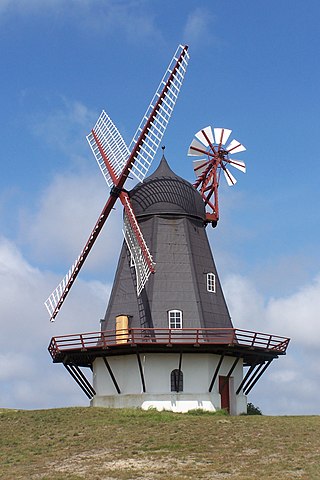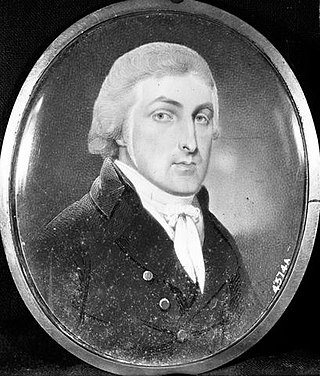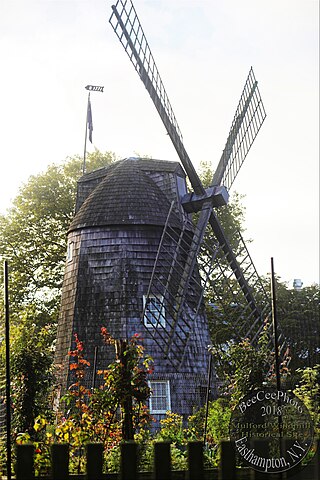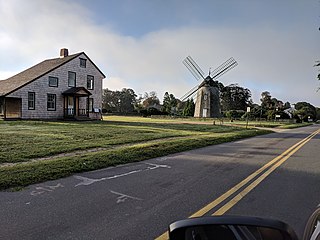
Gardiner's Island is a small island in the Town of East Hampton, New York, in Eastern Suffolk County. It is located in Gardiner's Bay between the two peninsulas at the east end of Long Island. It is 6 miles (9.7 km) long, 3 miles (4.8 km) wide and has 27 miles (43 km) of coastline.

The smock mill is a type of windmill that consists of a sloping, horizontally weatherboarded, thatched, or shingled tower, usually with six or eight sides. It is topped with a roof or cap that rotates to bring the sails into the wind. This type of windmill got its name from its resemblance to smocks worn by farmers in an earlier period.

Nathaniel Lawrence was an American lawyer and politician.

Boon Island Light is located on the 300-by-700-foot Boon Island off the southern coast of Maine, United States, near Cape Neddick. Boon Island Light has the distinction of being the tallest lighthouse in both Maine and New England at 133 feet (41 m). The lighthouse has a focal plane at 137 feet (42 m) above mean high water. The light's beacon flashes white every 5 seconds.
David Gardiner was an American lawyer and politician who served as a member of New York State Senate from 1824 to 1828. He was the father of Julia Gardiner Tyler, second wife of U.S. President John Tyler. He died in an explosion aboard the USS Princeton.

Iron Turbine Windmill is a historic windmill at 415 W. Gurley Street, on the grounds of the Sharlot Hall Museum in Prescott, Arizona. It is technically a windpump, but the American term is windmill.

Hayground Windmill is an historic windmill at Windmill Lane in East Hampton Village, New York. It was moved from Hayground to Pantigo between Two Mile Hollow Beach and Egypt Beach in the 1950s.

Beebe Windmill is a historic mill located at the southeast corner of Ocean Road and Hildreth Avenue in Bridgehampton, New York.

Shelter Island Windmill is an historic windmill north of Manwaring Road in Shelter Island, Suffolk County, New York. It was built in 1810. Master Millwright Nathaniel Dominy V (1770–1852) was the architect and builder of the windmill. The windmill has been on Shelter Island since 1840 and at its current location since 1926 on the Sylvester Manor farm.

Hook Windmill, also known as Old Hook Mill, is a historic windmill on North Main Street in East Hampton, New York. It was built in 1806 and operated regularly until 1908. One of the most complete of the existing windmills on Long Island, the windmill was sold to the town of East Hampton in 1922. The building was listed on the National Register of Historic Places in 1978 and is part of the North Main Street Historic District. The mill was renamed the "Old Hook Mill" and is open daily to visitors.

Corwith Windmill at Water Mill is a historic mill on NY 27 and Halsey Lane in Southampton, New York.

Wainscott Windmill is an historic windmill on Georgica Association grounds in Wainscott, New York in the Town of East Hampton. Georgica Association grounds are both within Wainscott and the Village of East Hampton to the east. Historically, it is known as one of the most frequently-moved windmills on the east end. It was added to the National Historic Register in 1978.

East Hampton Village District is a historic district in East Hampton, New York.
Jonathan Thompson was an American merchant, banker and politician.

The Pantigo Windmill is an octagonal smock mill in Easthampton on Long Island, New York. Bearing a 1771 weathervane on top, the James Lane structure was added to the National Register of Historic Places in 1984 as a contributing property of the East Hampton Village District.

The mill cottage on the Lion Gardiner farm at 36 James Lane on the landmarked East Hampton Village green has become a museum displaying 19th and early-20th-century landscape paintings. It is a contributing structure on the NRHP East Hampton Village District, replacing the original cottage on the lot situated with the windmill and Rev James historic marker.
The Dominy craftsmen were a family made up of American clock, furniture, and watch makers in East Hampton, New York. Nathaniel Dominy IV, his son, Nathaniel V, and his grandson, Felix Dominy were active from about 1760 to 1840. Works created by the Dominys are in the collections of Winterthur Museum, Garden, and Library. As of 2022, a museum dedicated to the Dominys is under construction in East Hampton.
The Tide Mill at Southold, erected in the 1640's by Thomas Benedict, holds a place of distinction in American history as the first recorded English mill in the New World. It paved the way for future tide mills and contributed to the economic growth of the Southold community..
Samuel Schellinger, was a millwright of Amagansett, New York and the craftsman who built the Pantigo windmill (1804), the Hayground Windmill (1809), the Amagansett windmill (1814) and the Beebe Windmill (1820) which are on the NRHP. Later, he built the Setauket windmill. Records show he built or worked on seven windmills and repaired others.



















